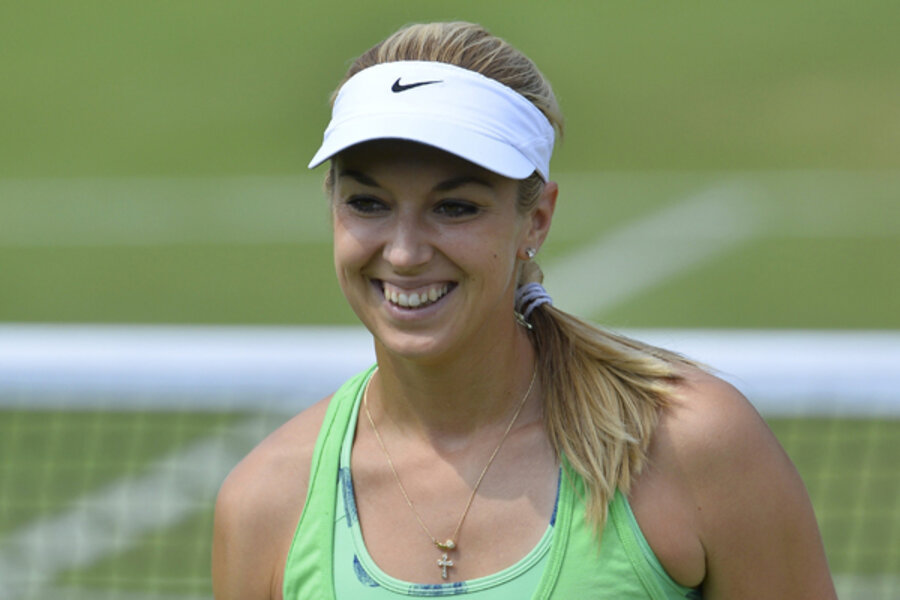Sabine Lisicki: Overcoming opponents and obstacles to reach Wimbledon final
Loading...
| London
Sabine Lisicki is allergic to Wimbledon, sort of.
Not the town in southwest London, and not the All England Club. But she does have hay fever, making her hypersensitive to the very grass for which the tournament is so famous.
That affliction, of course, won't stop her from playing in the Wimbledon final Saturday, when either she or Marion Bartoli will end up with a first Grand Slam title.
"I learned how to cope with that," Lisicki said Friday. "In the beginning, the first time I was here, which was, what, five years ago, I really was struggling with the allergies. But by now I know what to do, what to take, to calm those allergies down."
She also knows what to do on the tennis court when she steps onto the finely manicured lawn on Centre Court.
On Thursday, the 23rd-seeded German rallied from a 3-0 deficit in the third set to beat Agnieszka Radwanska and reach her first major final. She did the same thing in the fourth round, when she eliminated defending champion Serena Williams.
"I had a lot of challenges on my way to the finals with players being aggressive, players who were very solid, moving very well," Lisicki said. "So it will be another challenge."
Saturday's match will be only the second time in the 45-year Open era that two women who have never won a Grand Slam trophy will play for the championship at the All England Club. And it's difficult to say who has the edge.
Bartoli has been in this position before, reaching the 2007 Wimbledon final before losing to Venus Williams. And she hasn't lost a set so far this year, winning all six of her matches in straight sets. But Lisicki is 3-1 against Bartoli, including a win at Wimbledon two years ago when the 23-year-old German reached the semifinals.
"A final of a Grand Slam is always a matter of details. Maybe a point here, a point there will make the difference," said Bartoli, now 28 and much more experienced than the last time she made it this far. "Maybe someone who is a bit more gutsy than the other player, someone who is having a better day than the others.
"Sabine is definitely serving faster than me, especially on the first serve," Bartoli added. "I might take the ball a bit earlier. But obviously we both have the same thing, playing fairly flat and from the baseline and trying to hit some winners."
Lisicki's power game is something to note. Her hard serves have earned her the nickname "Boom Boom Bine," a moniker she shares with another German tennis great, three-time Wimbledon champion Boris Becker.
On Friday, "Boom Boom Bine" took a moment to seek out some advice from "Boom Boom Becker."
"I asked him a couple of questions, how it was for him," Lisicki said. "He won the first final he was in, so that's pretty good."
Lisicki has also been receiving well-wishes from Steffi Graf, the last German woman to win the Wimbledon title in 1996. But Bartoli has Amelie Mauresmo on her side, a 2006 Wimbledon champion who now coaches France's Davis Cup team.
After years of disagreements and disputes with the French tennis federation, Mauresmo has brought Bartoli back into the national team fold. And she has been watching Bartoli during her run to the final, even extending her stay at Wimbledon as Bartoli extended hers.
"She's helping me with the way I need to deal with my stress and with my energy out of the court. Sometimes I was losing too (much) energy being too focused for too long, especially a lot of times before the matches," Bartoli said. "I felt when I was going on court, I was already tired from it."
Part of her relaxation routine — and Lisicki's, too — entails music. Both said they listen to certain tunes when they are gearing up for a match.
"Bob Sinclar, 'Summer Moonlight.' The same track over and over," Bartoli said.
"When I walk on court, probably 'Play Hard,'" Lisicki said, referring to the David Guetta song.
Soon enough, the music in their ears will give way to the thwack of the racket and the sound of the crowd. That's when one of the two will start on the path to being a Wimbledon champion.
"I just want to be better than my opponent," Lisicki said. "That's all I'm thinking about."







